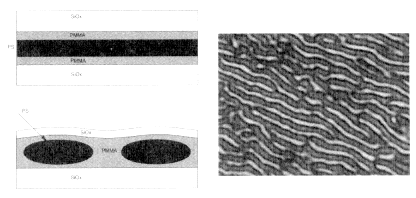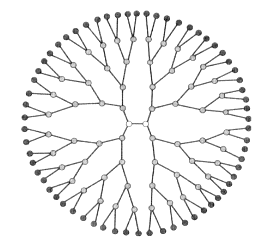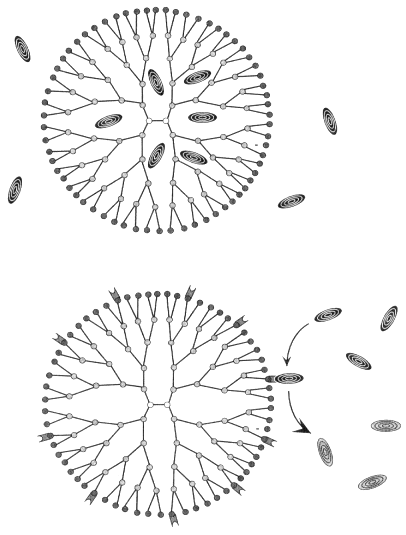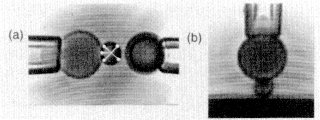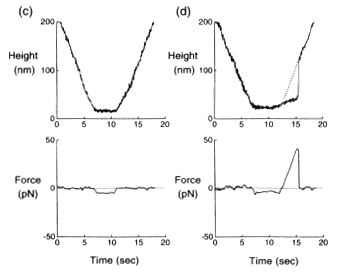Page 194
5
Soft Condensed Matter: Complex Fluids, Macromolecular Systems, and Biological Systems
The vast territory of "soft" materials extends to paints, surfactants, porous media, plastics, pharmaceuticals, coatings, ceramic precursors, minerals in suspension, foodstuffs, textiles, proteins, fats, blood, and guitar strings. These materials are composed of colloids, gels, emulsions, micelles, foams, liquid crystals, polymer melts, and other regimes of organization.
Biological physics, widely regarded as a major growth area for physics in the next decades, is already closely allied with the study of macromolecules and complex fluids—both active subfields of physics today. Labeling these as separate fields is already arbitrary, and with good luck, separation will become impossible. Chemical synthesis using biological methods will create huge classes of materials amenable to physical experiments. Physical techniques and principles will come to be applied to biological materials in unexpected ways.
This new domain of physics includes phenomena ranging from the precise agility of liquid crystals to the lurches and shudders of sandpiles, from the resilience of rubber to the self-organizing structure of soft surfaces, and from neuromuscular twitch to single-molecule mechanics.
A major difficulty in preparing this report was how to organize it into topics. The word "interdisciplinary" inadequately denotes the new paths of learning, distinct from those identified in earlier surveys and in university curricula. This chapter discusses the following:
• The necessary combination of traditionally distinct fields of physics, chemistry, and biology;
• The relentlessly increasing complexity of the materials examined;
Page 195
• The imaginative and exciting use of these materials; and
• The birth of new physics based on the theme of softness, malleability, and fragility.
It is only through basic research, rather than goal-driven manipulations of materials, that the essential connections between structure and function will emerge. Practical applications, whose development is often easier to support, will flow more easily once basic connections between structure and function have been elaborated. This chapter argues for research that, at its best, celebrates the complexities of the source material while taxing scientists' ingenuity to knead those complexities into tractable and relevant form.
There are abundant new industrial and medical products based on the softness and fluidity of materials. In fact, there have been uses from ancient times. The softness of rubber was enjoyed in pre-Columbian American ballgames. Emulsions and foams such as mousse and hollandaise sauce have long been used in food preparation. Today's new products are often discovered by ingenious trial and error rather than by systematic theory and physical understanding (see Box 5.1). The experience of practical innovation becomes a source of information to learn the general features of these soft materials.
Understanding inevitably leads to practical use, but it can take decades to progress from initial scientific query and curiosity to practical application. From the invention of the transistor to the first useful integrated circuits took about 20 years. From the realization that DNA stores the genetic code to the beginnings of a viable biotechnology industry took even longer.
With soft materials there are several unusual challenges to be recognized. Our effort to see what is common and mutually constructive in working with diverse soft materials immediately encounters cultural differences between physicists, engineers, and biologists. Particularly at the intersection between biology and physics, barriers to learning from each other are daunting. More than in any other chapter of this report, the primary emphasis here is on educational needs and opportunities for students and professionals. Following are a few examples of learning opportunities that would cost little compared to the large potential rewards:
• Summer schools,
• "Bilingual" survey texts and tutorials,
• Continuing education,
• Industry-academic visitation and collaboration,
• Grant programs to encourage truly basic research, and
• Graduate training in chemistry, physics, and biology.
Education must be deep as well as broad; it must obviate departmental boundaries. Nothing is more challenging than the creation of optimal modes of training
Page 196
| BOX 5.1 The Use of Milk Proteins |
| The world produces 5 × 1011 (500,000,000,000) liters of milk each day. Some of this is directly consumed. A major part is processed or used to supply industrial components. The milk protein casein, for example, 170 million pounds of it per year in the United States, is put into bakery products, medicines, adhesives, paper, low-fat coffee whiteners, and synthetic whipped dessert toppings. |
| Milk is a fragile mixture of fat and proteins in water. The structure and composition of fat globules, casein micelles, globular proteins, and lipoprotein particles have the malleability to allow them to be made into hundreds of butter, cream, yogurt, and cheese products. Their natural "complex fluid" properties are the kinds that physicists are now beginning to recognize. |
| In the dairy industry, processing is often guided by ingenious trial and error. The condensed-matter physics of soft matter can now have a chance to contribute here. The gelation of fat globules and proteins, the distribution of gel networks, and the size of nano-droplets of dispersions—which change the texture, taste, and feel of food—are in fact physical properties amenable to systematic physical investigation. |
in fields that traditionally disdain each other. The complexities of materials are themselves challenging enough to require no elaboration. New materials and properties are now studied in physics departments; at the same time there is increasing need for good physics in biology and engineering departments.
It is said that one of Isaac Newton's greatest achievements was to extract from Johannes Kepler's notebooks the two Kepler Laws that showed Newton the way to the discovery of gravity and the explanation of planetary motion. The notebooks and their calculations were themselves inspired by Tycho Brahe's astronomical observations. There is an analogy here to modem soft-materials research.
Biological systems present a set of successful molecular mechanisms that create the living state. The path of trial and error to industrial success leaves a valuable though diffuse trail of information. To pick out tractable essentials from these data is a challenge that might lead to the discovery of what makes a system live, today's equivalent of Newton's realization of gravity. The very mass of new data creates its own challenges. Entire genomes of species, including our own, are being mapped. Already one hears biologists speak of a "post-genomic era" when new thinking will be needed to work with the new information and new materials. Much of that thinking is expected to come from physicists.
Condensed-matter and materials physicists are used to thinking in terms of emergent phenomena in large complex systems (see Chapter 3) and understand that the simple paradigm that "structure determines function" can easily fail because of collective phenomena. However, much of our experience is in rela-
Page 197
tively simple systems with a great deal of symmetry (translation symmetry in a ferromagnet, for example). We need to be looking for new deep concepts in biology. These will necessarily require thorough knowledge of the details of structure, but will, we hope, capture fundamental and general principles of function.
The committee foresees possibilities for a shift to biologically based industry, for advances in medicine, for insight to understand and simulate the thinking process itself. The study of soft materials—such as complex fluids, macromolecules, colloidal suspensions, and biological preparations—is already creating materials and processes with useful medical, industrial, and domestic applications. So successful has physics been in medicine that the view of physics is distorted by its success. Virtually all the sophisticated hardware used in medicine is based on physical techniques and innovation of the kind described in this report. Physical gadgets are saving so many lives that nonphysicists often believe that gadgetry is the right place for physics in biology and medicine. Practical by-products should not deflect attention from the central message that basic research will ultimately bring much greater rewards.
Complex Fluids
As though condensed fluids were not already sufficiently complex (see Box 5.2), condensed-matter physics has defined "complex fluids" in an effort to investigate the suspensions and solutions of large molecules. Here "large" begins with the nanometer size of proteins and high polymers and extends to the micron-plus dimensions of colloids, liquid crystals, and grains of sand. Particles of this size organize themselves by steric collisions that create unexpected symmetries and sensitivity to boundary surfaces. Their interactions are governed by electrostatic and solvation forces in forms not seen between smaller particles.
Liquid Crystals and Microemulsions
Most large asymmetric molecules, viruses, and lipids assemble spontaneously into ordered structures whose dimensions and macroscopic properties vary dramatically with small changes in the conditions under which they are formed. The statistical mechanics of these assemblies challenges the best theorists, and measurements of macroscopic behavior and microscopic structure are a primary activity in materials research. Since the early 1960s it has been known that what underlies the phase diagrams of lipid-water mixtures is a set of lamellar, hexagonal, cubic lattices whose dimensions and symmetry change with temperature, concentration, and the salts dissolved in the water phase.
Force measurements on lamellar stacks of sheet-like membranes reveal steric repulsion resulting from the loss of thermal motion. The collisions between these sheets can be hard bumps or soft encounters through spatially varying electro-
Page 198
static, van der Waals, and hydration forces. The stability of a lamellar array reflects the interplay of all these factors, together with the layer flexibility that allows thermal undulation in the first place.
Similar reasoning holds for the packing of rod-like particles such as slightly flexible linear polymers and some viral particles.
Pursuing a sudden opportunity to examine the huge number of new liquid-crystal phases with natural and artificial materials in solution, theorists are
| BOX 5.2 An Enduring Challenge: The Structure of Liquids |
| Formulation of a paradigm for the structure and transport properties of liquids that is as compelling as periodicity is for crystals or "sparseness" is for gases remains one of the grand challenges of science. The periodicity of the crystal allows precise definitions of lattice excitations (phonons) and crystal defects (vacancies, dislocations), which let us understand in detail its thermodynamic properties, atomic transport, and deformation. Kinetic theory plays a similar role for gases. |
| The complexity of the liquid structure arises from liquids being almost as dense as crystals without the organizing principle of periodicity. The phase space of a liquid contains many closely spaced energy levels with low barriers between them. Computer simulations have produced many models of liquids, in excellent agreement with the data from diffraction experiments. Nevertheless, a simple, unifying picture of what gives rise to these structures and their associated transport behavior is still missing. |
| One approach to achieving such a picture is the introduction of large numbers of defects into a crystalline lattice. These models fail to make a specific link to the experimental and computational features of the liquid structure and are thermodynamically unsatisfactory. The alternative approach starts from the gas and gradually densifies it. Keeping track of the atoms, however, is a difficult task, and the formalism required to account for the thermodynamic and transport properties becomes quite complex. |
| The closest we have come to formulating a simple paradigm for the liquid is the "polytetrahedrality" of monatomic liquids, which goes back to a suggestion by F.C. Frank. The densest local configuration of equal spheres is a tetrahedron. Close packing of these tetrahedra around a common center leads to the formation of (imperfect) icosahedra, which, through their fivefold symmetry, explain the lack of periodicity. Although it is not possible to fill three-dimensional (3D) Euclidean space with perfect tetrahedra, it is possible to make a perfect packing of tetrahedra as the curved 3D surface of a four-dimensional polytope (see Figure 5.2.1). This surface can be mapped onto 3D Euclidean space by the introduction of line defects (disclinations), and the pair distribution function of the resulting structure is in good agreement with experiment. |
| Although this approach comes closer than any to defining a structural paradigm, more work is clearly needed, such as an extension to larger clusters and the detailed study of the defect lines—their identification in computer models, their systematic enumeration and statistical mechanics, and a demonstration of their role in atomic diffusion and viscous flow. |
(Box continued on next page)
Page 199
(Box continued from previous page)
| The study of glasses is particularly useful here because they allow us to narrow the energy range and hence the number of configurations of the liquid that need to be considered. Metallic glasses are the prime experimental systems to test the above paradigm because, unlike network-forming or organic glasses, the building blocks of metallic glasses are single, spherically symmetrical atoms. All glasses are intrinsically unstable; they are formed when the liquid goes out of equilibrium when cooled below the glass transition temperature. As a result they can continuously lower their free energy by a process of structural relaxation. Study of these relaxation phenomena yields unique additional information about the structure and defects of these glasses. |
|
|
| Figure 5.2.1 Two-dimensional projection of the 120 vertices of 720 nearest-neighbor bonds of a four-dimensional polytetrahedral polytope. The perfect tetrahedral packing in this structure is the organizing principle of the structure of simple liquids. |
creating a new language of structure and symmetry. From the observed structure of these phases, experimentalists construct materials of controlled microscopic structure, symmetry, density, and thermal conductivity. For example, the fragile cubic lattice of a lipid-water microemulsion can be perfused by water-soluble monomers that are then polymerized to create a hardened tortu-
Page 200
ous network. These materials have extraordinarily high surface areas for their volume and can be engineered to host chemical reactions that must progress on surfaces.
Polymeric microemulsions—i.e., polymer equivalents of microemulsions—have been identified. Thus it may now be possible to make inexpensive blends out of immiscible polymers and create particles whose sizes are tens of nanometers. To control particle size precisely, we must understand the kinetics of formation of these microemulsions out of their highly viscous polymer components.
Liquid crystals of lipid and water can hold DNA or drugs to deliver them through the lipids of the membranes that protect biological cells. Strategies are being developed to transfect cells by delivering alien DNA across this protective barrier, while protecting the DNA so as to allow it to become part of the target cell's genome.
Specialized domains in cell membranes that surround cells confine proteins to force them into two-dimensional order. Physical theory and measurement of lateral organization is already an important part of the search to explain the origin and function of these functional regions.
Colloidal and Macromolecular Interactions
During the past 10 years there has been a burst of measurements of the forces between colloids and macromolecules: polystyrene lattices, membrane bilayers, and biological macromolecules such as DNA and collagen in solution. Optical tweezers (see Figure 5.1), atomic-force microscopes, osmotic stress, electric and magnetic fields, and immobilizing surfaces have been used to position nanometer- to micrometer-size particles and measure the forces between them. At more than nanometer separations, there are clearly defined electrostatic double layer interactions; at smaller distances, solvation and the properties of the restructured solvent often dominate intermolecular forces. Taken together, this body of measurements introduces us to a new physics of the forces that act to organize biological macromolecules and colloidal suspensions.
Having entered the realm of solvation forces, one is immediately confronted by the embarrassing realization that many of them would not have been predicted beforehand. Measured forces frequently look nothing like those predicted by the computer simulations of biomolecules generated by programs used to predict structure and design drugs. Double-layer electrostatic forces have been known for decades and behave much as expected, even though qualitative discrepancies between observation and expectation occasionally occur. Short-range, exponentially varying forces at the nanometer range, usually dubbed ''hydration forces," are still only formally described. A rigorous theory needs to recognize not only the restructuring of the solvent in the face of the intrusive interface, but also the way that the macromolecular surface has been engineered by nature to work into
Page 201
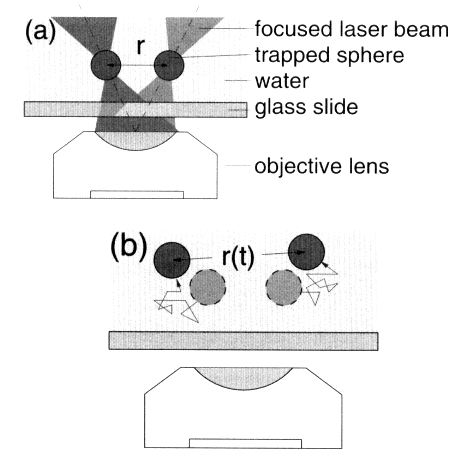
Figure 5.1
The laser grip of optical tweezers makes it possible to position two micron-sized
spheres at a specified separation. When the laser is turned off, the spherical
colloids begin to diffuse. This diffusion is followed through computerized image
analysis of the spheres' motions as seen through a light microscope. From the
paths of the two colloids after release, it is possible to infer the forces between
the spheres. If they repel, the spheres drift apart. Micron-sized spheres can be
positioned at various locations to test the consequence of proximity to
surfaces. (Courtesy of the University of Chicago.)
the structure of the solvent. All the usual difficulties that impede understanding of highly structured liquids are amplified by the minute details of macromolecular structure.
Still, the empirical facts speak for themselves, telling us how to think more logically about molecular organization. New forms of colloidal crystals and suspensions can be designed using measured forces. Computer algorithms can be
Page 202
reconstructed to incorporate observed forces. Phase diagrams of assembling molecules and colloids can goad far more careful thinking about the statistical mechanics of liquids and liquid crystals.
For colloids, practical applications will probably come sooner than fundamental theories. New ways to position materials to effect force measurements are also new ways to organize those materials for practical use. Colloidal systems are particularly promising, in that there is already extensive experience in their synthesis and commerce. The peculiarities of unexpected forces in response to manipulation become new ways to make industrial materials such as paints, slurries, and hitherto unimagined suspensions or colloidal gels.
We can expect that basic research will be increasingly able to point the way to practical design. For example, it has been known for years that polymers attached to colloidal particles can act as ''bumpers" to prevent aggregation by steric repulsion. Now we have measurements of forces between polymer layers attached to solid surfaces or to bilayer membranes. Theories of polymer steric repulsion can be critically tested. Application of polymers to surfaces can be designed for desired properties.
Conversely, polymers that are in solution but unable to associate with colloids can act to create depletion forces that act to drive the colloids together. These forces can be created, measured, and controlled by connecting known properties of polymers to observations of how those polymers change colloidal forces. Micron-size colloids can be concentrated into lattices of such good order that they are beginning to be used to create optical devices that work by diffraction and absorption of light.
Polyelectrolytes
Polymers whose properties are dominated by their electrostatic charge are instructive because of their solution properties, their ability to control ion activities, and their propensity to form liquid crystals. Among biopolymers, DNA has been the most intensely studied from the viewpoints of liquid-crystal physics as well as its "solution" properties in the cell. Intermolecular forces have been measured in detail, both for molecules in simple salt solution and for those organized by natural condensing agents. There has been extensive work aimed at modeling the electrostatic potential around DNA.
Among artificial materials, there are several electrically charged or polarizable polymers, both natural and synthetic, that form networks controlled by applied electric fields. Some of these materials are block copolymers, neutral as well as charged, whose long-range order can be seen to emerge from mesogenic organizing centers in the molecules themselves. Enhanced stiffness in polyelectrolytes can be achieved by neutralization with oppositely charged aliphatic surfactant molecules. Modest electric fields can be particularly effective in creating organization in liquid-crystalline polymers. Large-scale organization
Page 203
can also be induced by shear processing these materials because, like most mesomorphic materials, they readily align in shear flow.
The interplay between the various degrees of flexibility and freedom and the electrostatic forces within and between molecules creates many modes of packing and stimulates theories of molecular organization. The need is for complete theories that include real force potentials rather than analytically convenient approximations. Precise determination of phase structure from x-ray and neutron diffraction, combined with direct measurement of the work of assembly, will be essential.
At the moment, DNA is probably the friendliest polyelectrolyte, natural or synthetic, used to create well-defined liquid crystals in water. Soon there should be other made-to-order polymers in practically any single length. Polydispersity, a major nuisance when testing theories of polymer assembly, is not an impediment with uniformly engineered DNA. It may even be that the size regulation so useful for fundamental studies will also make DNA and other precisely prepared synthetic model compounds similarly useful for practical applications. Because they are highly soluble in water, polyelectrolytes might come to replace organic polymers, which must be dissolved in environmentally unsuitable solvents.
Polysaccharides
Although the substance of enormous industries (see Box 5.3), polysaccharides have been relatively unappreciated by most polymer chemists and physicists. Cellulose, whose biomass exceeds that of any other natural polymer, was not even mentioned in the National Research Council's 1994 survey of polymers.1 At present, modifications in chemistry and physical processing are creating new research questions and many practical applications, from the design of new paper currencies to the creation of industrial fibers to cosmetics to artificial food and blood thickeners.
It has recently become possible to measure equations of state of several polysaccharide systems, a development that should demand better theories of polymer assembly. Considering the mass of polysaccharides in the world, their economic and practical importance, and the excellent chemical and biochemical work already done, it is surprising that physical research has been so limited. Because polysaccharides are often polymers of repeating units, they would seem to be an ideal material for physicists to study. There is a splendid opportunity here for instructive physics on materials far less complicated than the more popular proteins. Their swelling properties, their viscous and elastic capabilities, and their stability over a wide range of solution conditions and temperatures are theoretically intriguing and technically enticing. There is already the expectation of creating bacterial polyesters and biodegradable ther-
1 Polymer Science and Engineering: The Shifting Research Frontiers, National Academy Press, Washington, D.C. (1994).
Page 204
| BOX 5.3 Growth of the Use of Polysaccharides: Xanthan, Guar, and Cellulose |
| The label on a bottle of salad dressing, a box of ice cream, a coffee whitener reminds us of the various polysaccharides that we consume. Among these many polymers of sugar are guar from seeds, carrageenan from seaweed, pectin from fruits, and xanthan from the coats of microbes. These compounds are used as thickeners and preservatives, often playing a role parallel to that played in natural circumstances. Xanthan is so versatile, so stable in its physical properties in the face of heating and mixing with salts that it is pumped into the ground to stimulate the recovery of oil wells and into your stomach after giving food the right "mouth feel." The animal polysaccharide hyaluronic acid is a significant component in cartilage and connective tissue; commercially extracted from animals, it is increasingly used medically for the repair of joints and cartilage. |
| It is no surprise then that natural polymers, or slightly modified natural polymers, are industrially popular. Several billion pounds of starches from plants are used in the United States alone for processing paper and in sizing, binding, and adhesive applications. Hundreds of millions of pounds of modified cellulose find their way into foods as well as paper and construction materials. |
| Viscous and elastic properties make these polymers industrially valuable. These are physical properties. Yet physics has paid surprisingly little attention to polysaccharides and related polymers. With its new capabilities, soft-matter physics can be expected to recognize and to modify the behavior of these materials that have traditionally enjoyed the attention mainly of chemists, colloid scientists, and chemical engineers. |
moplastics. The natural polysaccharides that coat some bacteria are able to direct the precipitation of minerals dissolved in the surrounding solutions; heroic hopes for deep-sea mining might be coupled to learning how tiny bacteria collect minerals.
Taken in the context of polymer studies in general, there is the possibility to study materials that have already been selected by nature for their physical properties. Most industrial use has been guided by trial and error rather than by combination with systematic physical theory and experiment. In the food industry particularly there are huge potential benefits.
Macromolecules and Macromolecular Films
Phase Separation and Ordering in Thin Polymer Films
Because diffusion is so slow in molten polymer systems, physicists have been able to observe the very early stages of phase separation—stages in which change is so slight that simplified, linear theories can be applied. It is possible to see the importance of polymer chain length on the kinetics and evolution of chain
Page 205
morphologies, the different classes of behavior approaching critical points, and the effects of surfaces and interfaces on phase separation. Phenomena that can only be observed in atomic or molecular films when they are, at most, 5-nm thick can be seen in 500 nm thick polymer films. Because of this extra range, it has been possible to see phase separations as a function of time and position from an organizing surface. Patterned surfaces can be templates to create three-dimensionally patterned films (see Box 5.4).
Structured films of synthetic and of natural polymers can be used as substrates to host and guide the growth of biological tissues. New processing treatments of surfaces for medical implants might follow from fundamental discoveries on thin polymer films.
New Macromolecular Materials
Dendritic and hyperbranched polymers have quite dense structures but nearly monodisperse size distributions (from 2 to 50 nm). These macromolecules can be tethered to surfaces to act as "bumps" to prevent the "stiction" of hard-disk drive heads; they can also be used to separate active ions such as erbium in optical amplifiers. The nature of the surface of these dense macromolecules, their behavior in solutions and melts, and their internal structure all have physical consequences. Their compact, well-defined shape stops mutual interpenetration or strong entanglement, which creates low-viscosity melts and solutions. Potential applications include their use as highly reactive, low-viscosity components for construction of thermosetting polymer networks. Spherical and wedge-shaped "monodendrons" can be produced (see Box 5.5). Attached hydrophobic groups create a variety of cylindrical crystal structures with ion-conducting channels. The possibilities of design are so encouraging that we have begun to speak of biomimetic polymers. The scale of the opportunities afforded can perhaps be gauged by the degree to which planar macromolecular assemblies (i.e., self-assembled monolayers) are currently being investigated by polymer physicists.
Flexible polymerized or "tethered" membranes are natural generalizations of linear polymers. Examples include graphite oxide sheets, the "rag" structure of MoS, and the spectrin skeleton of red blood cells. Theory predicts a remarkable flat phase, with anomalous roughness and singular elastic constants, caused by a delicate interplay between thermal fluctuations and the Gaussian curvature. The behavior of defects such as dislocations in unpolymerized flexible membranes (such as lipid bilayers) with local crystalline order is also remarkable. Unlike crystalline films forced to be flat by a surface tension, it is energetically favorable for these defects to buckle into the third dimension (see Figure 5.2). The macroscopic result is a "hexatic" membrane with a finite dislocation density at any low, but nonzero temperature, i.e., a membrane with zero shear modulus but with extended bond orientational order and a continuously variable fractal dimension.
Page 206
| BOX 5.4 Control of Phase Morphology |
| Films of phase-separated polymers can be forced to take on a microscopic lamellar structure when the film is "capped" by stiff coating. |
| A mixture of the immiscible polymers polystyrene (PS) and polymethylmethacrylate (PMMA) in a bulk melt forms a disordered arrangement of large (>1 µm), almost pure PS and PMMA phase domains. Remarkably, if a thin film of a mixture of PS and PMMA on a silicon oxide (SiOx) substrate is quenched so that phase separation is prevented, then capped with an additional layer of SiOx, and finally heated to allow demixing to occur, a very regular pattern of the PS and PMMA domains can result. A schematic of the domain structure through the film thickness is shown (Figure 5.4.1). |
| The figure shows that there are many long, parallel phase-separated domains with a well-defined periodicity within the plane of the film, necessarily accompanied by a periodic deformation of the upper film surface. The periodicity scales with the thickness of the polymer film and disappears if the SiOx capping layer is very thick; in this case the film consists of a uniform, five-layer sandwich, SiOx/ PMMA/PS/PMMA/SiOx. The structure comes from a balance between the free energy associated with forming the interfaces between PS- and PMMA-rich domains and the free energy increase associated with the elastic bending of the silicon oxide capping layer. These factors create both the lateral morphology observed for small capping layer thickness and the transition to only five layers (SiOx/ PMMA/PS/PMMA/SiOx) as the capping layer thickness is increased. |
| A notable feature of many liquid crystals and macromolecular films is their extraordinary sensitivity to their bounding surfaces. A change in surface tension or surface stiffness can be felt even millimeters away from the surface. This kind of sensitivity to outside influence is an unexpected tool for arranging molecules into desired microscopic form. |
|
|
| Figure 5.4.1 |
Page 207
| BOX 5.5 Dendrimers, Strictly Spherical Polymers |
| We usually think of polymers as a string of flexibly linked beads. It is possible, though, to link together Y-shaped units. The pattern of regular branching creates spherical dendrimers, whose precisely determined diameters are ~100 Å (Figure 5.5.1). These spheres can be coated with a variety of chemical groups so that their microscopic surfaces can have different qualities. Surface chemistry controls the way these tiny spheres move and pack under concentrated-solution conditions. |
| The viscosity of such dendrimer fluids is much lower than that of normal polymers, leading to novel applications. In dilute suspensions, chemically labeled dendrimers can be directed to react specifically with desired sites. One possibility is that single dendrimers, loaded with drugs, will release those drugs at the places to which dendrimers have been directed to bind (Figure 5.5.2). Another is that partial dendrimers, dendrons, with liquid-crystal elements will self-assemble into arrays of cylinders with precisely tailored inner and outer surfaces. These cylinders may find uses as engineered channels through cell membranes. |
| Because they can be engineered so reliably and because of their rigidly simple spherical shape, dendrimers are a powerful research tool. The idealized models used in many physical theories resemble the well-defined spherical structure of dendrimers. In addition the structures of dendrimers can be systematically modified to test predictions of physical theories. |
|
|
| Figure 5.5.1 |
(Box continued on next page)
Page 208
| BOX 5.5 Continued |
|
|
| Figure 5.5.2 Single dendrimers (top) "packed" with drugs and (bottom) releasing the drugs at specified binding sites. (Courtesy of the National Institute of Standards and Technology.) |
Page 209
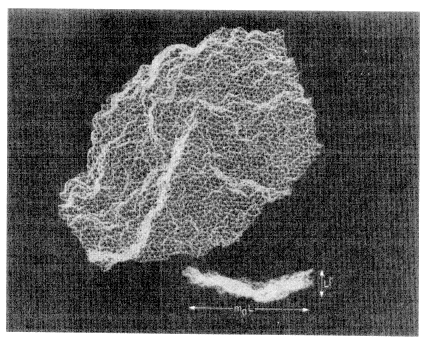
Figure 5.2
The crumpling of a membrane sheet. Perspective and side view of an
instantaneous configuration of a large tethered membrane composed
of 4219 monomers. [Reprinted with permission from F.F. Abraham and
D.R. Nelson, "Diffraction from polymerized membranes," Science 249,
394 (1990). Copyright © 1990 American Association for the
Advancement of Science.]
Associating polymers are molecules with hydrophilic backbones and two or more associating hydrophobic groups ("stickers") per chain. These polymers have very unusual rheological properties because of the tendency of the associating groups to cluster and form transient networks at sufficiently high polymer concentrations. Their dramatically altered solution elasticity and viscosity allows applications as thickening agents and rheology modifiers.
Unfortunately, most systems have stickers that are randomly placed along the chain; such associating polymers are poorly understood. New synthetic methods now allow us to prepare systematically varied molecules with specified number and location of stickers. Polyelectrolytes and polyampholytes, with similarly daunting structural heterogeneity can now be more systematically produced. The possibility of learning from the properties of these molecules leads naturally to related phenomena, such as protein folding and the organization of polymer systems of increasing but controlled "randomness."
Polymers associated into gels will hold drugs whose diffusive release into the body can be controlled by gel compactness. These gels can be placed in a particular
Page 210
part of the body for local, directed, sustained drug release. Stable substrates of synthetic and natural polymers create substrates for directed cell culture.
Structural Polymers: Controlling Properties of New Polymers from Old Monomers
Polyolefins, so-called ''commodity polymers" such as polyethylene and polypropylene, are produced in huge quantities by the petrochemical industry. Polymer production for U.S. consumption alone is about 1011 pounds per year. This is roughly equal to steel production in weight, but it is about seven times steel production in volume. Polyolefins are nearly 60 percent of the total. These polyolefins are cheap. Their chain architecture can be manipulated by relatively crude methods that offer some control over branching and stereoregularity of the chain. In the early 1990s, polymer chemists developed new transition metal catalysts. These catalysts offered unprecedented freedom to copolymerize the olefins with other monomers, they also allowed much tighter control over branch content and stereoregularity. It is now possible to achieve properties for ethylene-containing polymers that range from those of good elastomers (soft, with only a very small fraction of tiny crystals to act as crosslinks) to highly crystalline (hard) polymers. This wide range of properties can be achieved using a very cheap monomer to make up most of the polymer. Great commercial and scientific opportunities exist for polymer physicists to develop the relation between chain architecture and the properties of these new materials.
For example, high-density (unbranched) polyethylene of high molecular weight is used routinely for the socket of artificial hip joints. For this use it has an elastic modulus of 103 GPa and a failure stress of only 50 MPa. The same polyethylene, processed with solvent into a dilute gel, dried, and then drawn into fibers, has an elastic modulus of 170 GPa and a failure stress of 3000 MPa along the fiber direction. Processing methods such as fiber spinning, blow molding, injection molding, extrusion, film blowing, solution casting (for adhesives and coatings), and reactive blending subject the molten polymer or polymer solution to a flow field that strongly distorts or aligns the molecular conformations. Such processing is able to effect the final material properties after cooling, cross-linking, or evaporation of solvent. Trial-and-error improvement in commercial processing will be more efficient with better theories of polymer organization.
The most serious lack of knowledge concerns what determines the mechanical properties of semicrystalline polymers and how they depend on flow history and polymer architecture. Because ease of processing and final properties are equally important attributes of a polymer, both melt theology and final properties need basic study. Studies in the 1970s did not emphasize the strong effects of flow, which can reorganize the orientation of crystals and change crystallization rates by orders of magnitude. Modern physical probes (e.g., small-angle neutron
Page 211
and synchrotron x-ray scattering, infrared dichroism, and Raman spectroscopy) could provide the tools to understand the transient effects of flow on the molecular conformation, crystallization, plastic deformation, and fracture.
Biological Connections
In contrast to synthetic polymers, which are composed of at most three monomer types, normally arranged in random order, proteins are synthesized according to a programmed sequence involving 20 kinds of monomer. They are also produced to a precise length. Other classes of biopolymers, such as saccharides and nucleic acids, are also very precisely specified compared with artificial synthetics; even heterogeneity appears to be intentionally created. Polymer chemists and molecular biologists have begun to collaborate to synthesize copolymers with the same precise control of monomer sequence and chain length. The challenge for polymer physicists, as precision-architecture polymers become available, is to understand the link between architecture and polymer system properties. Lured by the wide range of properties conveyed by biological macromolecules, from spider silk to the elastin of blood vessel walls, we expect to see polymers with similarly remarkable properties emerge from these new syntheses. Given the vast range of possibilities and the small initial quantities of each polymer, it will be necessary to develop methods for rapid screening. Scanning-probe microscopies have begun to be used to determine mechanical properties. The aim is to be able to screen polymers for desired properties with the same efficiency that is achieved for developing and producing biological polymers by the natural checks of evolution and growth.
Biological Systems
Biological molecules are substances that have evolved to do highly specific jobs on highly specific timescales. Physicists have had impressive success studying the dynamics of macromolecules, particularly proteins. The mechanics of single molecules can be measured and used to test theories of molecular conformation. The measured energies of packing biopolymers inform us of the work needed to package them into cells and viruses and challenge us to explain and manipulate macroscopic properties.
It helps to distinguish incidental and essential physical properties of biomolecules. For some materials, such as DNA, the cell works with physical properties because it must. For others, such as RNAs, proteins, lipids, and polysaccharides, molecular physical properties are themselves useful to the organism. There are bulk materials that provide structural stability to the cell or organism. Happily, the language and concepts of lyotropic liquid-crystal physics often meet the need to examine biological materials.
Page 212
Two Traditions of Learning Must Merge to Allow Systematic Progress
For there to be the necessary crossover between biology and physics, there will have to be a significant change in the way we teach ourselves and our students to handle new materials and to respect the natural ways designed by patient evolution. In the ideal scenario, physics students will learn the facts and methods of biochemistry and molecular biology, and biology students will lose their fear of and skepticism about talking with physicists (and perhaps even learn some physics). In this area more than in any other addressed by this report, progress will have to follow education. It will be built on a developed respect for the very different thinking and experimental methods used by the two ''sides." This point is far more pertinent than any review of particular systems or prediction of future events. A 1996 study on self-assembling biological materials2 nicely summarizes the current state of learning about molecular organization and provides many examples of doing physics with biomaterials, including:
• New paths for synthesis of peptide (proteinaceous) chains with practical properties as well as properties that will be available to test physical models of assembly;
• Spontaneously assembled surfactants, both natural and synthetic, with their possibilities for structuring surfaces, hosting proteins or DNA or molecular sensors, binding stabilizing polymers, and (again) creating structures amenable to systematically developed theories of lipid assembly;
• Layered polymer systems that can act as sieves, scaffolds for growth and hardening of nonorganic materials, and mechanically stabilizing films; and
• Gene therapy, in which physical methods might be used to design the delivery and incorporation of new genes to be reproduced within the genome of target cells.
The committee enthusiastically agrees with that study and will not repeat its advice here. Rather, this section will provide more examples for both basic and applied research. It will suggest possibilities for a physics of biological materials in which physical thinking will be essential to the understanding of how biological substances are designed to work in their native habitat. There are many biological phenomena that traditionally or currently have been studied productively through physical thinking. Some examples are as follows:
• Protein-DNA and protein-protein interactions;
• Molecular motors and locomotion;
• Protein interaction, folding, and dynamics;
2 National Research Council, Biomolecular Self-Assembling Materials: Scientific and Technological Frontiers, National Academy Press, Washington, D.C. (1996).
Page 213
• Photosynthesis and energy transfer; and
• Nerve action.
Physics and Structural Biology
If allotted text were in proportion to progress, the discussion of molecular structure determination and structural biology would nearly fill this chapter. Because of advances in physics, we now expect to know the structure of large functional biological molecules in crystals and in solution to angstrom resolution. Any thinking about functional mechanisms is expected to build on known structures. Although structure determination of proteins in solution is usually by nuclear magnetic resonance (NMR) and is considered the province of chemists, most structures are delineated by x-ray diffraction, whose procedures are predominantly the work of physicists. New sources—synchrotrons, free-electron lasers, and high-power x-ray laboratory generators—together with better lenses (e.g., optical fibers, multilayer optics, and single-capillary microbeams) and a new generation of fluorescence and charge-coupled device detectors, offer the possibility not only to determine structure but to observe several classes of molecular motion (see Figure 5.3).
Synchrotrons, neutron sources, laboratory x-ray generators, and NMR machines, with their ancillary detectors and computation algorithms, are practical microscopes whose success can be measured in the number of publications involving their use, number of students studying and using them, and numbers of dollars expended on them. Increasingly precise molecular structures, frequently with better than 1 Å resolution, are the product of strong light sources as well as better handling of delicate materials. Bright synchrotron sources are especially useful for time-resolved studies, in which snapshots of the structure can be taken in small time increments to make it possible to study intermediate states during kinetic processes such as protein folding, allosteric changes, and association or dissociation. Observable time resolution can be as short as nanoseconds, with about 0.1 ns expected soon. Here, as elsewhere in this report, we note the need to nurture these facilities, improve them, and expand them so that they can continue to meet and encourage the growing demand for revealing molecular structure, assembly, and dynamics.
More urgent is that, while the world grows x-ray and NMR rich, it remains neutron poor. Neutron and x-ray scattering, as well as NMR, allow us to study the solution structure and dynamics of proteins and lipids and, perhaps, devise industrial applications. Neutrons are sensitive to the positions of biologically abundant light elements such as hydrogen, carbon, nitrogen, and oxygen. Because of this, with hydrogen-deuterium isotope substitution for contrast, small-angle neutron scattering can provide unique information about the structure and function of biological macromolecules, protein-nucleic acid or protein-lipid complexes, and multi-subunit proteins. Neutron reflectivity has come to reveal fea-
Page 214
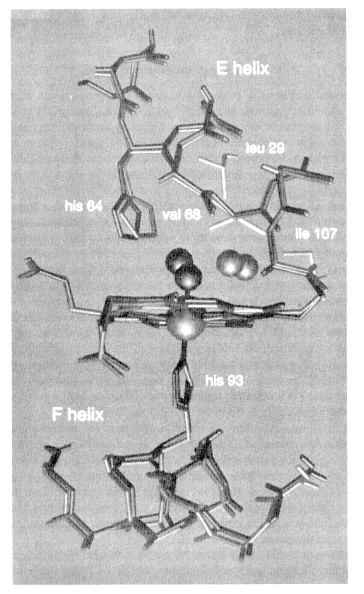
Figure 5.3
Quick clicks. High-power x-ray sources provide successive
pictures of a protein process. [Reprinted with permission
from W.A. Eaton, E.R. Henry, and J. Hofrichter, "Nanosecond
crystallographic snapshots of protein structural changes,"
Science 274, 1631 (1996). Copyright © 1996 American
Association for the Advancement of Science.]
Page 215
tures of lipid monolayer and bilayer systems in aqueous environments, especially for preparations that are difficult to crystallize. Reflectivity could similarly be used to aid the biosensor industry by measuring the interactions between biological components and organic or inorganic surfaces and to assist in the understanding of nonspecific binding of proteins to surfaces. Dynamic processes in macromolecules can also be probed directly by neutron scattering because scattering cross sections relate directly to oscillation frequencies and amplitudes of motion. Optical microscopic techniques like fluorescent energy transfer are very useful for obtaining information about proteins in vivo.
The need for good physics goes beyond mere observation. Today, about 35 years after the first hemoglobin structure, we still do not understand how that protein changes its binding affinity for oxygen by assuming distinct allosteric forms. Energy storage and energy flow through this nanometer-sized machine still deserve the attention of molecular biologists and biophysicists, who still have difficulty conversing.
Molecular Conformation and Protein Folding
The protein-folding problem attracts some of the best minds in biological physics and statistical mechanics, but it will require much more effort to reach satisfactory results. The question of how a linearly synthesized protein curls up to its three-dimensional functional form continues to challenge and excite theorists. The committee concurs with the eloquent review found in a recent National Science Foundation study.3 Decades of witty measurements and imaginative theories suggest that there can be some progress on this vexing problem, though success in prediction is still elusive.
At this stage, it is clear that physicists have defined the language in which folding is being examined. Cellular chaperone proteins, which wrap a protein during its transformation from a linear chain to a three-dimensional structure, are now believed to act by reversing random errors in folding. Their action is discussed by biologists and physicists alike in terms of their kicking the protein out of snarls that might otherwise trap it on its way to correct conformation. In this way, cellular activity is thought to facilitate what is essentially a statistical physical process. The tools to follow folding are increasingly based on physical techniques, particularly high-power, high-speed x-ray scattering and spectroscopy.
Single-Molecule Motions and Mechanics
Laser tweezers allow one to hold the ends of linear molecules, particularly double-helical DNA, to measure the force of extension in different solutions and
3 Ken Dill, NSF Workshop on Interdisciplinary Macromolecular Science and Engineering (unpublished), chaired by S.I. Stupp, University of Illinois at Urbana-Champaign, May 1997.
Page 216
with association with other molecules. Suddenly it is possible to think about single molecules as mechanical objects, on which physics can be performed analogous to that done on macroscopic materials. Pipette aspiration allows equivalent mechanical manipulations of membranes and bilayer vesicles (see Box 5.6). The various moduli and deformabilities are just beginning to be codified and connected with the language of mechanics. The actual values of these material properties still often surprise us and require new thinking.
Force microscopes can be used to break bonds, stretch molecules, or observe spontaneous changes in macromolecular conformation. The breaking strengths of important bonds, such as those between an antigen and an antibody, have been observed using labeled polystyrene lattices. It has been found that the force needed to break a bond is a monotonically decreasing function of the time that the
| BOX 5.6 The "Spring" of a Bubble to Tug Apart Large Molecules |
| Many biological processes depend on associations that require no chemical bonds between molecules. Important examples are the association between antigens and antibodies that allow cells to recognize alien matter or between integrins that hold cells together. Even without being pulled apart, these molecules will spontaneously come apart with time. |
| In a functioning cell, the precisely controlled duration of molecular association can be more important than the strength of association. Cells create characteristic times for many processes by controlling association times. The measurements illustrated here show how times of association between a single pair of large molecules can be measured and instructively varied. |
| The trick is to pull on the molecules with a spring whose rate of tugging (force/ time) can be varied by 100,000,000 times (see Figure 5.6.1). Springs are made from lipid bilayer vesicles or from red cells—effectively bubbles or microscopic bags—to which associating molecules can be strongly attached. The bubble is held by being gently sucked into a pipette whose suction pressure can be varied to change tension in the vesicles. |
| To set up the measurement, a molecule on one bubble is brought near to another bubble that contains the mating molecule; the bubbles stick at the point of molecular contact. Then, by sucking on the pipette, stretching tension can be transmitted to the two molecules. The time to breakage of the antigen/antibody bond varies with varied rates of applied tension. From this measured time-to-breakage, it is possible to infer the kind of contact that the molecules made and, more important, to learn how the molecules create their important times of association. |
| In this particular example, binding is observed between biotin and avidin. Dissociation time ranges from 0.01 seconds to 100 seconds after the onset of a ramped force. These gentle-tug measurements show how association lifetimes can be exquisitely sensitive to small changes in applied structural forces. Physical forces can regulate cellular events. |
(Box continued on next page)
Page 217
(Box continued from previous page)
|
|
| Figure 5.6.1 Using a bubble to tug apart large molecules. (Courtesy of Boston University and the University of British Columbia.) |
force is applied. This connection between time and strength, understandable in terms of diffusion in the presence of a distance-dependent bonding potential, reveals the dynamics of molecular association in the context of biological control. One can expect many single-molecule systems to be observed and analyzed by probe microscopies to create a nanomechanics of molecular force and assembly. There is already a small literature on the spectroscopy of single proteins trapped in small spaces and illuminated by narrowly focused laser light.
Through the combined efforts of structural biologists, muscle biophysicists, and statistical physicists, force generation in muscle and in transport within cells is being seen as the combination of stochastic events and directed response. The conversion of chemical reaction to directed physical action has posed a funda-
Page 218
mental problem because of the different symmetries of biochemical cause and physical effect. The puzzle is being solved through molecular tracking and stochastic models. We can now expect the design of new mechanical transduction systems.
Single ionic channels show electrically detectable transitions between "open" and "closed" configurations, whose probabilities are a function of solution conditions as well as the applied transmembrane electric fields. There is now a possibility of studying the dynamics of the channel molecules, as well as the solution components that affect them, simply by watching singular molecular events over very long times (see Figure 5.4). With channels, as with other proteins, it has been recognized for almost 30 years that occupation of the different conductance states follows simple Boltzmann statistics that allow us to relate the probabilities of different states with the changes in energy needed to achieve them. In fact, for a channel or other responsive molecule to sense changes in condition, it is necessary that there be small differences, comparable to the thermal energy kT, in the energies of differently functioning states.
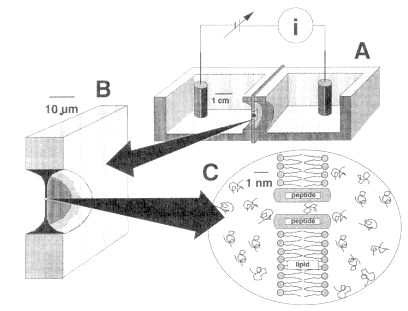
Figure 5.4
A molecular Coulter counter. A bilayer membrane between two
chambers contains a single ionic channel of ~1 nm diameter. If a
small molecule moves into an open channel, the event is seen as
a reduction in electric current. The duration of this reduced
current measures the residence time of the molecule diffusing
into and out of the channel. [Reprinted with permission from
S.M. Bezrukov et al., "Counting polymers moving through
a single ion channel," Nature 370, 279 (1994).
Copyright © 1994 Nature.]
Page 219
As a next step in time-resolved, small-current detection, it is possible to see changes in the "open" state when single molecules enter and exit the channel. In this way it is possible to measure the statistics and dynamics of flexible polymers as they move within the confines of a precisely defined single-molecule structure.
What does it mean to watch the changes in a single molecule? Can one use rigorous physics to describe these changes? Can this physics give us the energies and entropies that drive the system to different states? The answer seems to be yes. Statistics, statistical mechanics, and functional control present a perfect chance for physicists to bring their methods to help biologists. There can be ready extrapolation to create practical devices, such as detectors and computers, informed by biological designs, While single-molecule thinking inspires a new statistical mechanics of strongly coupled systems with enormous fluctuations.
It is known now that many biological systems, from single ionic channels to entire sensory systems, practice a kind of stochastic resonance. Physicists in the 1920s realized that adding some noise to a weak radio signal could improve signal detection. Today's physicists and biophysicists have succeeded in generalizing those ideas, raising the hope that they might be applied to helping the heating-impaired.
Protein dynamics are a subject of intense interest. Binding of small molecules (see Figure 5.5) and changes in protein shape are essential properties that physicists are in an excellent position to explain. Timescales are especially worth recognizing here. Nerve signals, for example, occur on timescales of milliseconds, and different nerve channel proteins act at slightly different rates. Single molecules remain "open" or "closed" for milliseconds. These millisecond-characteristic times reveal the limits of computer simulation. Considering that these simulations can cover only nanoseconds, there is still a factor of 106 to cover to connect molecular dynamics computations with functionally interesting molecular times. The wit of physical theorists is the most promising way to compensate for this daunting factor in computation.
Molecular Association
There is justified pride in modem polymer synthesis, by which stretches of one or another kind of monomer allow polymers to associate in parts to multimolecular arrays of specific symmetry, packing, and material properties. Yet this kind of packing is rough compared to that of proteins or DNA, whose every monomer has functional consequence. One mutation in one amino acid of an antibody will qualitatively weaken its antigen-antibody binding strength and specificity. One change out of six nucleic acids will spoil that sequence for recognition by a protein that controls gene expression. Strength and specificity are what count when an antigen or a hormone binds to a cell-surface receptor at
Page 220
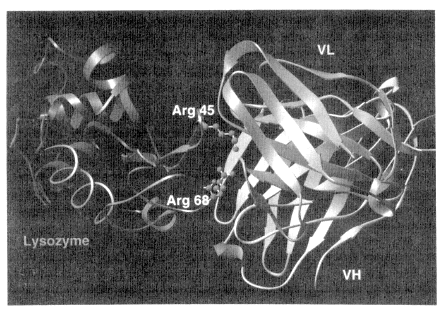
Figure 5.5
The right details: precision fit in the binding of an antigen to an
antibody. The antigen, a lysozyme protein nestles into an
antibody. A groove in the antibody matches itself tightly against
a ridge in the lysozyme antigen. This ridge is formed by two
arginines, at positions 45 and 68. Such is the precision of the
match that mutation of Arg68 to a chemically similar Lysine
reduces binding strength by a factor of 1000. [Reprinted by
permission from S. Chacko, E. Silverton, L. Kam-Morgan,
S. Smith-Gill, G.H. Cohen, and D.R. Davies, ''Structure of an
antibody-lysozome complex. Unexpected effects of a conservative
mutation," Journal of Molecular Biology 245, 261-274 (1995).
Copyright © 1995 Academic Press.]
the end of a molecule that reaches through the cell membrane into the cell itself, where it can organize internal machinery just from the tension created by external binding. Even as x-ray diffraction reveals the intricacies of the essential contacts, we have no more than cartoon ideas of how energies are transmitted and applied. Physical opportunities abound.
Between the chemists' syntheses and nature's precise machining, there is the possibility to work both ways: to use new tricks in synthesis to create molecules with preferred properties, and to make changes in nature's design—intentional mutations of natural structures—to modify properties.
Great possibilities will be realized here when physicists trained to think about molecular organization are also trained in the much easier crafts of synthesis, mutation, modification, and manipulation. For example, biosensors are being designed with biological materials for contact with the species to be detected and electrodes with integrated circuitry for amplified response.
Page 221
Consequences of the Human Genome Project and Other Genome Determinations
Probably the most difficult question to speculate about is the consequence to materials physics that will result from mapping of the human genome. It is hard even to describe the magnitude of the information being collected. It will be possible to synthesize and to mutate virtually every protein in our bodies or in the body of any known organism. There are about 100,000 identifiable human genes. The number of possible mutations is burdensome to behold. Given the 3 billion base pairs that compose our genome and the possibility of putting 4 different letter pairs at each of these 3 billion positions, the number of mutations easily exceeds anything one would try to change systematically and exhaustively.
In the context of this chapter and this survey, it is to the learning opportunities for materials research that these numbers direct our attention. Physicists can learn to produce any protein in desired quantities and to process and package it with increasing skill. Excellent demonstration of this comes from the synthesis of polypeptides of relatively simple sequence. The lure to create new industrial and medical materials compels us to think how these gene products can be designed and manipulated.
Simply knowing the amino acid sequence of a protein is yet not enough to predict its properties. Similar to the exasperation we suffer in studying collective quantum behavior (Chapter 3), difficulties in understanding proteins come from their ability to achieve the unpredictable properties that emerge because of their physical size.
As suggested at the beginning of this chapter, the nub of the matter is education. Ideally, physics students will soon be as comfortable with gene-processing procedures as they are with other ways to manipulate materials. New substances whose properties differ qualitatively from those usually considered by physicists, even in these advanced and exciting times, will also confront them.
It is probably pointless even to speculate about what we will be able to do with all these new techniques and manipulations. There is already a National Research Council study on new technology based in molecular biology.4 Natural polymers such as silk and collagen will sooner or later be produced synthetically. It is possible to imagine using elastin, the animal's equivalent of rubber, as an industrial product. Talk of DNA computers and molecular motors is no longer strictly speculation or science fiction. Administration of gene therapy will come to be guided by the principles of organization learned from preparing condensed arrays of genetic material. Physicists who know how to make these materials will be in an excellent position to think about how they work and how to work with them using physical intuition.
4 Biomolecular Self-Assembling Materials: Scientific and Technological Frontiers, National Academy Press, Washington, D.C. (1996).
Page 222
Biological materials present a large opportunity for condensed-matter and materials physics research and application. At the same time, they present a large uncertainty in the time needed for that opportunity to be realized. It is difficult to predict the seminal moments in an untried marriage of new physics and new biology.
Directions and Priorities
Despite the many different kinds of research described in this chapter, a few general themes emerge. From these themes we can identify needs and priorities for the support of research on soft materials.
Physicists have lost their pessimism about doing good physics on complex materials. Whether in physics departments or in other departments, they are studying biological materials for practical as well as fundamental research. Among many physicists there is huge optimism over the learning opportunities provided by biological systems, in spite of conflicting traditions of learning and reasoning. Although the necessary development of physics in biology can be expected to proceed naturally, the course and pace of this merger are uncertain.
The deformability and other macroscopic features of soft condensed matter are now routinely examined in terms of their microscopic structures and their large thermal fluctuations. We already think of the various forms of soft matter in terms of molecular arrangements, rather than their macroscopic properties. Biological processes are coming to be routinely discussed in atomic detail. With adequate support, structure determination and structural thinking can be expected to grow rapidly for at least another 10 years.
The ability to observe, to manipulate, and to characterize single molecules and to measure forces that create functional groupings of molecules is new and exciting. Mechanical properties and biological functions such as information transmission are increasingly discussed in terms of molecular structure. A science of single molecules or similarly small objects—as mechanical objects, as functioning machines, as interacting bodies—an be expected to have a large impact on biological science and on the development of artificial materials.
New tools of synthesis create new polymers and reproduce or modify natural biological polymers. These tools will become increasingly useful in the design of practical materials, medical, industrial, and domestic, and will enable systematic basic research to relate molecular cause and macroscopic effect.
Because of the complexity of the materials being examined, physicists are learning to manipulate a much larger range of material properties than had been thought possible before. Flow, deformability, microscopic patterning, strength, and durability are being evoked from substances previously not considered to have such possibilities. From better ways to design for particular properties, we may hope that industrial progress will grow less empirical and more logical.
Page 223
Research on soft materials creates vast amounts of information. Whether in the possibilities built into the genetic code, the molecular details of protein structure, the many microscopic structures of liquid crystals, the nuances of medical scanning, the chemical possibilities of polymer synthesis, or the scrap heap of trial-and-error industrial innovation, the numbers that go into description are huge. The growing size, number, and kinds of data banks are teaching us new ways to organize and use information. We may expect physicists to grow increasingly comfortable working with such ''rich" systems.
Priorities
Education
When physicists work with materials that were once the province of other fields, and when scientists in those fields use what physicists have learned, they discover that there are different ways of learning, thinking, and even speaking in the different fields. It is easy to say that education in physics, chemistry, and biology must be broad as well as deep. It is easy to argue that tomorrow's condensed-matter physicists should not fear to synthesize polymers or handle proteins or express genes. Although such skills are easily learned, there are many obstacles to such broad learning. Even if there were time in school, subject matter changes too fast to rely only on what is learned in school.
Several strategies can be tried:
• Interdisciplinary workshops;
• Summer schools with laboratories, for scientists at all career stages;
• New courses for biologists in elementary physics and for physicists in wet chemistry, biochemistry, and molecular biology;
• Introductory physics instruction that emphasizes soft systems; and
• Bilingual texts—e.g., in biology and physics—that teach the vocabulary and basic phenomena of particular systems. (This may be a good time for another review for physicists modeled on the landmark 1959 series in Reviews of Modern Physics.5)
Basic Research
Industrial and medical results will follow naturally, as they have inevitably followed basic research in the past. Grant mechanisms can be established to encourage the necessary interdisciplinary work.
5 Raymond E. Zirkle, "Biophysical science. A study program: General features of radiobiological actions," Reviews of Modern Physics 31, 269 (1959).
Page 224
• Special grant programs to compensate for the double jeopardy that goes with the present system when research is judged both as biology and as physics;
• Fellowships developed and expanded for physicists to work in biological laboratories—the NSF-NIH one-year visit program is one example; and
• Contact between university researchers and industrial scientists and between physicists, chemists, and biologists to foster collaborations, particularly with the chemical, medical, and pharmaceutical industries.
The residue from trial and error in industrial research is an abundant source of information for new physics. Biological systems are an inspiring source of solved problems for doing physics in a new place. We can work to create comfortable common ground for collaboration.
Undersupported research areas should be identified in which results will be needed. For example, polyelectrolytes and biological polymers will be increasingly used for products to displace environmentally unfriendly organic materials.
Research Facilities
For structure determination, neutron sources in particular are urgently needed. Synchrotron x-ray, ion beam, transmission electron microscope, and surface probe facilities are high on the list. Data processing is needed for the large amounts of information being generated and the large computations that will be undertaken.
Overall
Intellectually, industrially, and medically, soft-material research has a potential that justifies funding increases like those being given to research in biology and medicine.

































